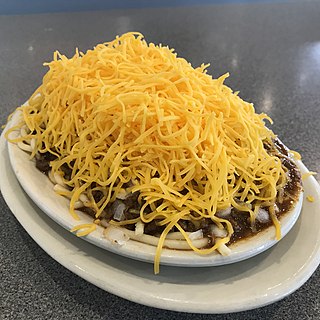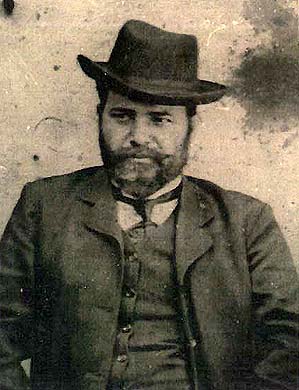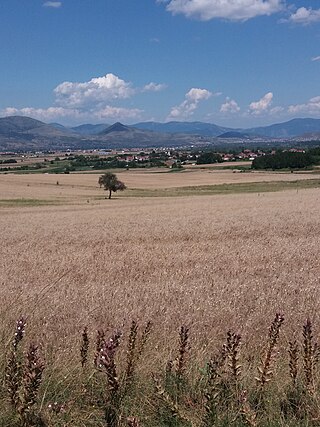
Tom Kiradjieff and John Kiradjieff were Bulgarian American restaurateurs and Macedonian immigrants, credited for their creation of a regional specialty dish known as the Cincinnati chili. [1] [2] [3]

Tom Kiradjieff and John Kiradjieff were Bulgarian American restaurateurs and Macedonian immigrants, credited for their creation of a regional specialty dish known as the Cincinnati chili. [1] [2] [3]
The brothers were born in the town of Hrupishta, [4] in the Ottoman Empire, [note 2] [5] to Bulgarian parents. [6] [note 3] [7] [8] The town was annexed during the Balkan Wars (1912-1913) by Greece. The partition of the Ottoman lands of the region of Macedonia between the Balkan nation-states resulted in the fact, that some of the Slavic speakers of Ottoman Macedonia emigrated to Bulgaria, or left the area. [9]
Athanas (Tom) was born in 1892. During the First World War, he was a soldier in the Bulgarian Army. In 1917 he was dismissed and moved to the Bulgarian capital Sofia, where he worked for a time as an accountant. [6] His little brother Ivan (John) born in 1895 had served also some time with the Bulgarian army. [4] In 1921 both emigrated to the United States.
They settled initially in New York, [10] but after selling hot dogs there for some time, the brothers followed their big brother Argir (Argie) to Cincinnati. Born in 1880, he was a cashier of the Bulgarian Exarchate Church-School Board in Hrupishta. [7] Argie had settled in Cincinnati by 1918, where he opened a grocery store. [11] In Cincinnati the brothers began to develop their own business. Tom got a job as a bank clerk and worked at night, cooking chili for the customers in his brother's place. It was at this time that Tom invented the regional specialty known as Cincinnati chili.
In 1922 they opened a hot dog stand located next to a burlesque theater called the Empress, which they named their business after. Tom and John returned to Bulgaria to find wives, while Argir went to his homeland for this purpose. Argir stayed there for several years, and when he came back, his two brothers were well established and provided him a job as a cashier. According to the journalist Vasil Stefanov, [note 4] in 1933 the Kiradjieff brothers were among the most successful Bulgarians in the city, owners of a large and modern restaurant in the city center. [12] [13]
Argir's wife did not adapt to America, and they moved back to Macedonia in the 1940s. [note 5] [4] [14] The Empress Chili grew to become a local chain. In 1959, the Kiradjieffs of Empress Chili, announced they be the first to come up with a new design for drive in, car-service. The last man who ran the family business was Tom's son Assen (Joe) Kiradjieff. Since the late 1950s, when his father's health sharply declined, Joe operated the Empress Chili. Tom died in 1960, while John had died in 1953. Later the Empress chain had a single surviving outlet. In 2009, 79-year-old Joe retired and sold the Empress Chili. [15]

The Internal Macedonian Revolutionary Organization, was a secret revolutionary society founded in the Ottoman territories in Europe, that operated in the late 19th and early 20th centuries.

Krste Petkov Misirkov was a philologist, journalist, historian and ethnographer from the region of Macedonia.

Cincinnati chili is a Mediterranean-spiced meat sauce used as a topping for spaghetti or hot dogs ("coneys"); both dishes were developed by immigrant restaurateurs in the 1920s. Its name evokes comparison to chili con carne, but the two are dissimilar in consistency, flavor, and serving method; Cincinnati chili more closely resembles Greek pasta sauces and spiced-meat hot dog topping sauces seen in other parts of the United States.

Hristo Tatarchev was a Macedonian Bulgarian doctor, revolutionary and one of the founders of the Internal Macedonian Revolutionary Organization (IMRO). Tatarchev authored several political journalistic works between the First and Second World War.

Kruševo is a town in North Macedonia. In Macedonian the name means the 'place of pear trees'. It is the highest town in North Macedonia and one of the highest in the Balkans, situated at an altitude of over 1350 m above sea level. The town of Kruševo is the seat of Kruševo Municipality. It is located in the western part of the country, overlooking the region of Pelagonia, 33 and 53 km from the nearby cities of Prilep and Bitola, respectively.

Petar Poparsov or Petar Pop Arsov was a Macedonian Bulgarian revolutionary, educator and one of the founders of the Internal Macedonian Adrianople Revolutionary Organization (IMARO). He is regarded as an ethnic Macedonian by the historiography in North Macedonia.

Dendrochori is a village in Kastoria Regional Unit, Macedonia, Greece. Dendrochori is located approximately 10 km northwest of Kastoria and 6 km east of the center of the community Kastraki — the village Ieropigi. Dendrochori has 266 inhabitants (2011).

Kalochori, is a small rural village, part of the municipal unit of Kastoria, Kastoria regional unit, Greece. Kalochori is also located 14 kilometers away from the city of Kastoria and 14 kilometers away from the village of Nestorio. It was a part of the former municipal unit of Mesopotamia. The village has an elevation of 721 meters above sea level.

The Bulgarian Action Committees in Macedonia were collaborationist nationalist organizations of Bulgarians in Macedonia during 1941, emboldened by the invasion Yugoslavia by Nazi Germany, determined to end the Yugoslav rule in the region, perceived as oppressive by Macedonian Bulgarians and by the representatives of other communities or political tendencies in Vardar Macedonia. They were also encouraged by the friendly relations between Nazi Germany and Bulgaria, and by the hope that after the German Army swept through the Bulgarian one succeed it. The time of the Bulgarian Action Committees was a time witnessing an acute lack of authority. The Serbs in authority positions had fled most of the region, not afraid of the Germans, but primarily of terror from their local collaborators. The Bulgarian Action Committees, sought to take control of the region for Bulgaria, laying the groundwork for Bulgarian rule. The Executive Committee of the organization was headed by: Stefan Stefanov from Kratovo, president, Spiro Kitinchev from Skopje, vice-president and Vasil Hadzhikimov from Štip, secretary. In Veles Bulgarian Action Committees received the active support by popular communist functionaries as Panko Brashnarov.

Ohrana were armed collaborationist detachments organized by the former Internal Macedonian Revolutionary Organization (IMRO) structures, composed of Bulgarians in Nazi-occupied Greek Macedonia during World War II and led by officers of the Bulgarian Army. Bulgaria was interested in acquiring Thessalonica and Western Macedonia, under Italian and German occupation and hoped to sway the allegiance of the 80,000 Slavs who lived there at the time. The appearance of Greek partisans in those areas persuaded the Axis to allow the formation of these collaborationst detachments. However, during late 1944, when the Axis appeared to be losing the war, many Bulgarian Nazi collaborators, Ohrana members and VMRO regiment volunteers fled to the opposite camp by joining the newly founded communist SNOF. The organization managed to recruit initially 1,000 up to 3,000 armed men from the Slavophone community that lived in the western part of Greek Macedonia.
Idomeni or Eidomeni is a small village in Greece, near the border with North Macedonia. The village is located in the municipality of Paeonia, Kilkis regional unit of Central Macedonia (Greece).

Theodosius of Skopje was a Bulgarian religious figure from Macedonia who was also a scholar and translator of the Bulgarian language. He was initially involved in the struggle for an autonomous Bulgarian Church and later in his life, he became a member of the Bulgarian Academy of Sciences. Although he was named Metropolitan Bishop of the Bulgarian Exarchate in Skopje, he is known for his failed attempt to establish a separate Macedonian Church as a restoration of the Archbishopric of Ohrid. Theodosius of Skopje is considered a Bulgarian in Bulgaria and an ethnic Macedonian in North Macedonia.
Lyalevo or Lyalyovo is a former village in southernmost western Bulgaria which ceased to exist in 1960. Lyalevo is known as the only village within the modern borders of Bulgaria that was inhabited by Greek Muslims (Vallahades).
Ilinden is a village in Hadzhidimovo Municipality, in Blagoevgrad Province, Bulgaria. It is located in a mountainous area, on the northern slopes the Stargach mountain. It is 14 kilometers southwest of Hadzidimovo Municipal Center and 18 kilometers southeast of Gotse Delchev. The climate is transitional Mediterranean with mountain influence with summer minimum and winter maximum of rainfall. The average annual rainfall is about 700 mm. The Mutnitsa River flows through the village. The soils are predominantly humus-carbonate.

Nova Lovcha is a village in Hadzhidimovo Municipality, in Blagoevgrad Province, Bulgaria.
Novo Leski is a village in Hadzhidimovo Municipality, in Blagoevgrad Province, Bulgaria.
Paril is a village in Hadzhidimovo Municipality, in Blagoevgrad Province, Bulgaria.

Lazar Poptraykov was a Macedonian Bulgarian revolutionary (komitadji). He was also a Bulgarian Exarchate teacher and poet from Ottoman Macedonia. He was one of the leaders of the Internal Macedonian-Adrianople Revolutionary Organization (IMARO) in the region of Kastoria (Kostur) during the Ilinden Uprising. Despite his Bulgarian identification, per the post-WWII Macedonian historiography he was as an ethnic Macedonian.

Selci is a village in Municipality of Struga, North Macedonia.

The Macedonian-Adrianople Social Democratic Group was a regional faction of the Bulgarian Workers' Social Democratic Party in the Ottoman Empire. According to Macedonian historians, most of its activists were ethnic Macedonians.